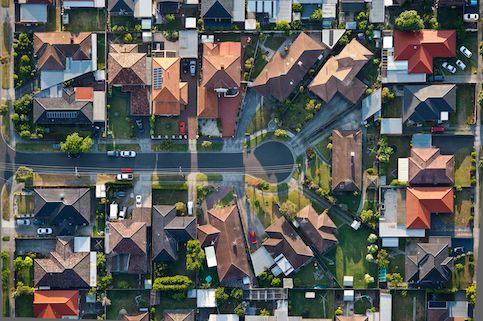Establishing a solid foundation for your journey into homeownership starts with a clear understanding of the mortgage preapproval process. In the following article, we’ll guide you through the essentials, explaining the significance of preapproval, how to attain it and the advantages it brings to your home buying experience. Whether you’re a first-time buyer or an experienced homeowner, this guide is designed to demystify the preapproval process, providing you with the knowledge and confidence to navigate the real estate market effectively.
What Is A Mortgage Preapproval?
A mortgage preapproval is a preliminary evaluation conducted by a lender to assess a borrower’s financial standing and determine the maximum loan amount for which they qualify. This process involves a thorough review of the borrower’s credit history, income, employment status and other financial details. While not a binding commitment, mortgage preapproval provides conditional approval, offering valuable insights into the borrower’s purchasing power and serving as a crucial step in the home buying process.
See What You Qualify For
Buy A Home
Discover mortgage options that fit your unique financial needs.

Refinance
Refinance your mortgage to have more money for what matters.
Tap Into Equity
Use your home’s equity and unlock cash to achieve your goals.
Benefits Of Getting Preapproved For A Mortgage
Consider the following compelling reasons to secure a mortgage preapproval before embarking on your home buying journey:
- Establishes how much house you can afford: The mortgage preapproval process considers your financial details, including income, credit history, and debt-to-income ratio when establishing how much house you can afford. The lender then determines the maximum loan amount for which you qualify, providing a clear picture of your purchasing power and helping you focus on homes within your budget during the house-hunting process. It serves as a valuable guideline for both you and potential sellers in real estate transactions.
- Shows sellers you’re a serious buyer: Acquiring mortgage preapproval signifies that a lender has conducted a comprehensive assessment of your financial qualifications and is ready to offer the required funds for a home purchase. This formal approval enhances your credibility in the real estate market, potentially giving your offer a competitive advantage and demonstrating a dedicated and prepared stance in the home buying process.
- Streamlines the house hunting process: Preapproval accelerates the house hunting process by offering a precise understanding of your budget and financial capacity. With preapproval in hand, you can concentrate your search on homes within your approved price range, facilitating more efficient decision-making when evaluating potential properties.
- Makes the closing process faster: Ensuring that the initial stages of the loan application have already been completed allows for a more streamlined and efficient closing, as much of the required financial documentation and assessments have already been addressed during the preapproval stage, reducing potential delays in finalizing the mortgage.
How To Get Preapproved For A Mortgage In 5 Steps
Obtaining mortgage preapproval can be a complex process with a lot of interdependencies. The following section will simplify the mortgage preapproval process into five crucial steps, providing you with a clear and actionable guide on how to navigate the complexities of securing preapproval for your mortgage.
Step 1: Carefully Time Your Preapproval Application
The most opportune moment to pursue mortgage preapproval is when you are genuinely prepared to initiate the home buying process. Seeking preapproval underscores your readiness to potential sellers and streamlines the subsequent steps when you find the right home. It’s important to note that preapprovals typically have a validity period, often lasting between 60 and 90 days. Therefore, it’s crucial to strategically time your application to coincide with the period when you plan to actively search for a home, ensuring that the preapproval remains in effect throughout your house hunting journey. This approach maximizes the efficacy of your preapproval in showcasing your financial capability and commitment to sellers when entering the real estate market.
Step 2: Choose A Mortgage Lender
In the process of selecting a mortgage lender, it’s essential to conduct thorough research and comparison. Start by exploring current interest rates and associated costs from various lenders using online tools and comparison platforms. Assess the reputation of potential lenders by reading reviews and seeking recommendations. Understand the different mortgage types and terms to determine which aligns with your financial objectives. Evaluate customer service quality, responsiveness and communication clarity. Check qualification requirements and consider obtaining prequalification or preapproval from multiple lenders for a comprehensive comparison.
Step 3: Gather Your Financial Documents
To get preapproved, you’ll need to provide your lender with financial documents for them to review as part of your application. These include, but are not limited to:
- Proof of income
- Proof of employment
- W-2s
- Bank statements
- Social Security number
- Current driver’s license
Step 4: Get Your Credit Checked
Your lender will conduct a thorough credit check to assess your credit score. This evaluation helps the lender gauge your current debt, payment history, and the types of debts you’ve managed in the past. A positive credit report, showing timely payments and debt reduction, positions you as a reliable borrower. Conversely, a history of missed payments or defaults may make lenders more cautious. Following this assessment, the lender determines the approved loan amount and the corresponding interest rate, providing you with a clear understanding of your affordable home price. This information is formalized in a preapproval letter, a crucial document you can present to prospective sellers to underscore your preparedness and credibility as a homebuyer.
Find A Mortgage Today and Lock In Your Rate!
Get matched with a lender that will work for your financial situation.
Step 5: Begin The House Hunt
Upon receiving a mortgage preapproval letter, your home search becomes a more strategic endeavor. Begin by carefully reviewing the letter to establish your approved loan amount, providing a clear budget for your property search. Define your home priorities, considering factors like location, size and amenities. Engage the expertise of a real estate professional to navigate listings effectively, utilize online platforms for research and attend open houses to visually assess potential homes. Stay organized in your evaluations, scheduling private viewings for promising properties. Consider future growth and additional costs, regularly reviewing and reassessing your priorities to ensure a dynamic and informed approach to your home search. The preapproval letter serves as a powerful tool, enabling you to confidently explore homes within your financial parameters.
Tips About Preapprovals For Mortgages
In the following bulleted list, we outline practical strategies and considerations to enhance your financial profile and navigate the preapproval process with confidence:
- Consider buying a house below your preapproved loan amount: Just because you’re approved for a certain amount doesn’t mean you should borrow that much. Choosing to purchase a home below your preapproval amount offers several advantages. It provides financial flexibility, enabling you to handle unforeseen expenses or shifts in your financial circumstances more comfortably. Moreover, buying below your preapproval limit can lead to more affordable monthly mortgage payments, contributing to a more sustainable budget. This approach also allows for flexibility in pursuing other financial goals or investments in the future.
- Don’t make any big purchases after you’re preapproved: Making major purchases before reaching the closing table can pose significant risks to your home buying process. Large expenditures may impact your debt-to-income ratio, potentially affecting your eligibility and loan terms. It could also raise concerns for lenders about your financial stability, leading to a reassessment of your loan application. To ensure a smooth final approval, it’s advisable to avoid major purchases that could alter your financial profile until after the mortgage has been secured.
- Build your credit score before getting preapproved: Building credit before seeking preapproval for a mortgage offers several key advantages. Firstly, a higher credit score often results in more favorable loan terms, including lower interest rates. Additionally, a strong credit history enhances your overall financial profile, instilling confidence in lenders and potentially increasing the likelihood of preapproval. Lastly, a solid credit foundation can broaden your range of mortgage options, providing you with greater flexibility and potentially saving you money over the life of the loan.
Mortgage Preapproval FAQs
Whether you’re a first-time homebuyer or navigating the real estate market again, this compilation of frequently asked questions aims to provide clarity on the nuances of mortgage preapproval, guiding you through the intricacies of this pivotal stage in the home buying journey.
What’s the difference between a preapproval and prequalification?
The distinction between preapproval and prequalification lies in their level of commitment and the depth of the evaluation process. Prequalification is an initial assessment based on unverified information provided by the borrower, offering a general estimate of loan eligibility. In contrast, preapproval involves a more comprehensive analysis, with the lender verifying the borrower’s financial information, resulting in a conditional commitment for a specific loan amount and terms. While prequalification provides a rough estimate, preapproval is a more rigorous and reliable indicator of a borrower’s potential to secure a mortgage.
What’s the difference between a preapproval and final approval?
Preapproval is an initial assessment by a lender indicating the borrower’s potential eligibility for a loan based on their financial information. It is not a binding commitment, but rather a preliminary step in the mortgage application process. On the other hand, a final approval is a conclusive decision by the lender after a thorough examination of the borrower’s financial documentation, property appraisal and other relevant factors, signaling the formal agreement to extend the loan under specified terms. Final approval marks the conclusive stage in the loan approval process, while preapproval is a preliminary evaluation.
Does it hurt your credit score to get preapproved for a mortgage?
Yes, obtaining a preapproval for a mortgage may have a minimal negative impact on your credit score that is typically temporary. Preapprovals usually involve a hard inquiry, which causes your score to drop a small amount. It’s important to limit the number of hard inquiries during the home buying process, as they can have a slightly more pronounced impact on your credit score.
Will multiple mortgage preapprovals hurt my credit score?
While a single mortgage preapproval is unlikely to have a significant impact on your credit score, obtaining multiple hard credit inquiries in a short time frame can potentially lower your score. Each mortgage preapproval involves a hard inquiry. However, if you do them all within a short time frame, they will only count as one. That allows you to shop around for the best terms. Keep in mind that if you take out another loan (like a credit card) it could count as another hard inquiry. This is why it’s advised you do not apply for other loans or take on new debts while in the process of buying a home.
Frequent inquiries may signal to creditors that you are actively seeking credit, which can be viewed as a risk.
How long does mortgage preapproval take?
The duration of a mortgage preapproval process varies, but it typically takes a few days to a couple of weeks. The timeline depends on factors such as the responsiveness of the borrower in providing necessary documentation, the complexity of the financial situation and the efficiency of the lender’s processing. To expedite the process, it is advisable for the borrower to promptly submit all required documents and respond to any inquiries from the lender in a timely manner.
Is there a downside to getting preapproved for a mortgage?
One drawback is that preapprovals are based on preliminary information and not a final loan commitment, so the terms could change during the full approval process. Additionally, having a hard inquiry may affect your credit score slightly. It’s essential to carefully review the terms and conditions of the preapproval and be mindful of the impact on your credit.
What if I don’t get preapproved for a mortgage?
If you’re unable to secure a mortgage preapproval, it doesn’t necessarily mean you won’t be able to obtain a mortgage. Preapproval is a preliminary step and not a final decision. You may still explore other financing options, work on improving your financial profile and seek guidance from a mortgage professional to identify steps for enhancing your eligibility in the future.
The Bottom Line
Securing mortgage approval is a crucial step in the home buying process. Acquiring a preapproval letter from your lender provides a more precise understanding of your affordable home price, empowering you to navigate the housing market with confidence.
When engaging in discussions with your lender for preapproval, ensure that you have all required documentation assembled and present your financial information in the most favorable light.
Take the first step toward buying a house.
Get approved to see what you qualify for.

Christian Byers
Christian Byers is a freelance writer and editor with experience covering diverse topics. He has a Bachelor of Science in Journalism and a Bachelor of Arts in Communications from Eastern Michigan University. His experience as a writer and editor includes publications such as The Eastern Echo, Rocket Central and Woodward Sports Network.












